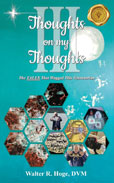
 |
Thoughts on My Thoughts Book III: The TALES That Wagged this Veterinarian
by Dr. Walter R. Hoge
MainSpring Books
True to the spirit of the title, the author undoubtedly runs the gamut of topics, yet each one, from the prism of the fictional McEaster Valley to the stories he told his children, speaks to the overall human experience and our responsibility to understand nature. The text appears to point to a better understanding of ourselves when we understand nature, which then can lead to understanding those with whom we interact. The inspiration, or rather catalyst, for the author envisioning McEaster Valley derives from tragedy—the loss of the mother of his children.
Right from the onset, Hoge’s discussion of out-of-body experiences assures readers that this isn’t a typical exploration of one’s thoughts. On the contrary, it is deeply researched with examples that probe deeper than what is at the surface level. Perhaps what makes the narrative so intriguing is Hoge’s ability to add descriptions for the layman to understand. There are rarely complex scientific terms but rather well-placed examples of imagery, such as “a feeling of floating outside your body, an altered perception of the world,” to create instant relatability with the audience. Of course, the most narrated out-of-body experience is in the operating room, where life and death hang in the balance, and the patient nearly always reports seeing a bright light among their other details.
As the work progresses, Hoge makes the reader at home with a soothing, conversational tone as he journeys into discussions of parallel universes—even attempting to explain them from a theoretical physics standpoint—and origin stories. His fearlessness in tackling notoriously polarizing topics with tact and knowledge is commendable. Interestingly, the work is far from barbershop fodder. Rather, it references renowned, influential figures like psychiatrist Raymond Moody Jr., author of Life after Life, works such as Viktor Frank’s Man’s Search for Meaning, and the Bible itself to add evidentiary support to his claims. Further, contemporary figures that made national headlines, like Damar Hamlin and his public health scare, keep youth audiences engaged and connected as well.
From the travails of Wilford Woodruff and Phoebe Whittemore Carter to the chaos surrounding four neurosurgery residents whose lives are nearly cut short yet intricately tied to near-death experiences, every new revelation, new story, and discussion is illuminating. In the case of Michael McLean, the direct commentary dives into faith and sexual orientation, one’s own identity, and the notion that praying harder would “correct” McLean’s son. The anecdote is even further magnified because of McLean’s deeply entrenched role within the church as a filmmaker and songwriter. In short, the author’s narratives impel the audience to react and discuss, to probe within themselves, and to challenge the status quo. Yet, each one takes the author back to McEaster Valley, where seemingly his innocence, peace, and nostalgia reside and where his fears are put to rest. Unsurprisingly, Hoge has a knack for connecting unrelated ideas, but the green light being emitted from the valley leads to a conversation on radioactivity, and how nuclear energy is likely the pathway into the next frontier for the world.
Aside from Hoge’s dissection of world issues, his reflections on McEaster Valley present a biblical utopia where the law of love resonates with all beings in this valley in as authentic a manner as humanly possible. Regardless, the communal nature of ants is given the same shine as the use of lasers and the discovery of the Yeti in the Himalayas. Truly, nothing is off limits for Hoge and his infinite reservoir of thoughts and commentaries on what makes our world tick. Including, but not limited to, talks on peer pressure, kindness, grief, ambition, and commitment, this text is filled with emotions that bridge birth and death.